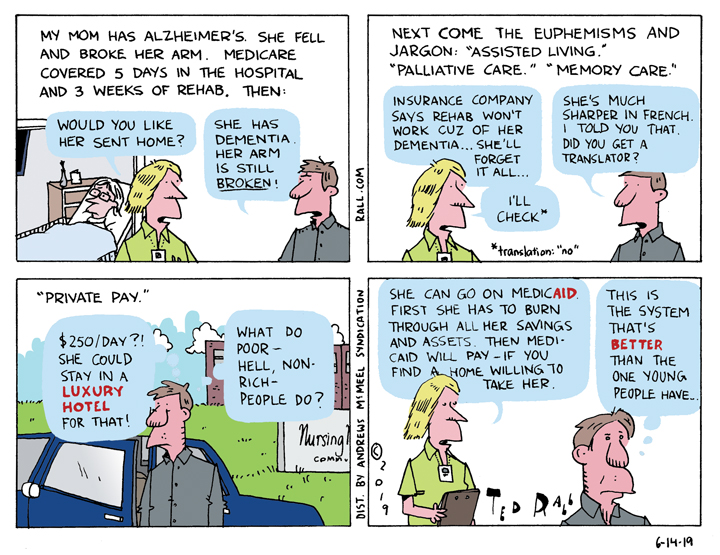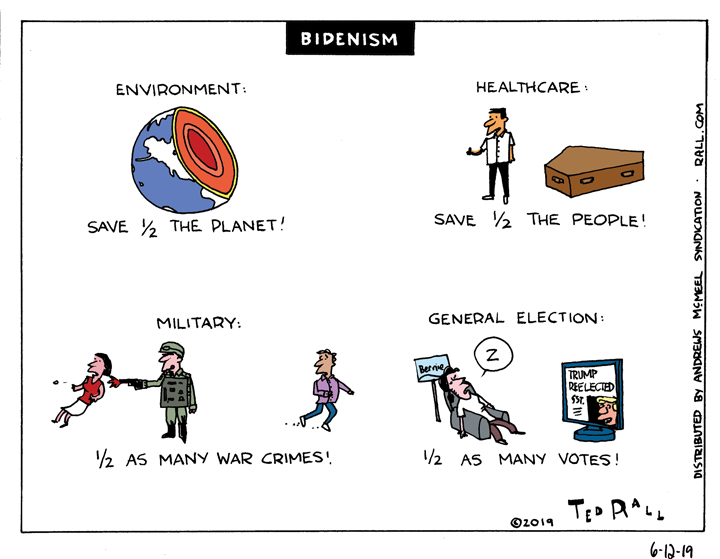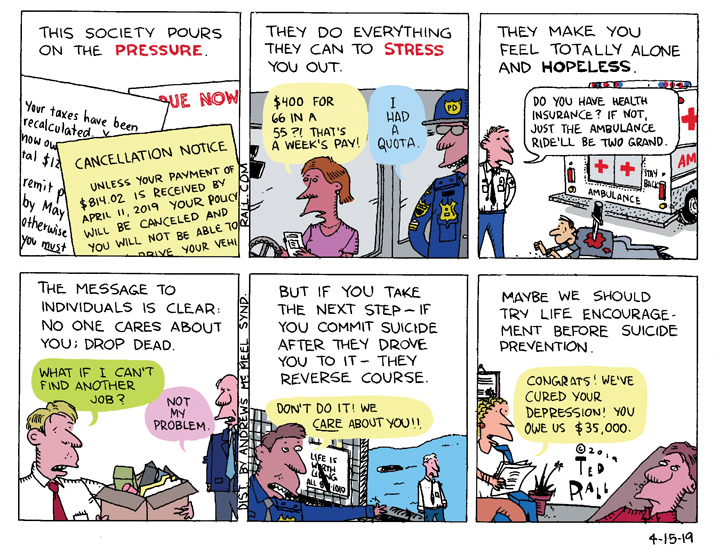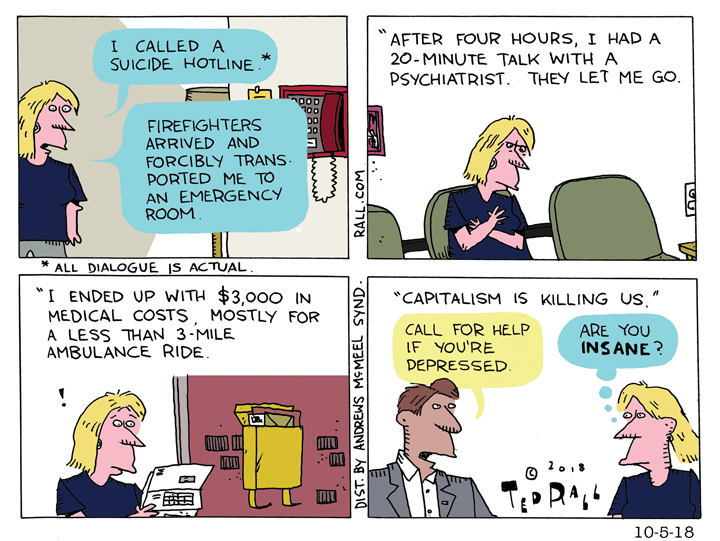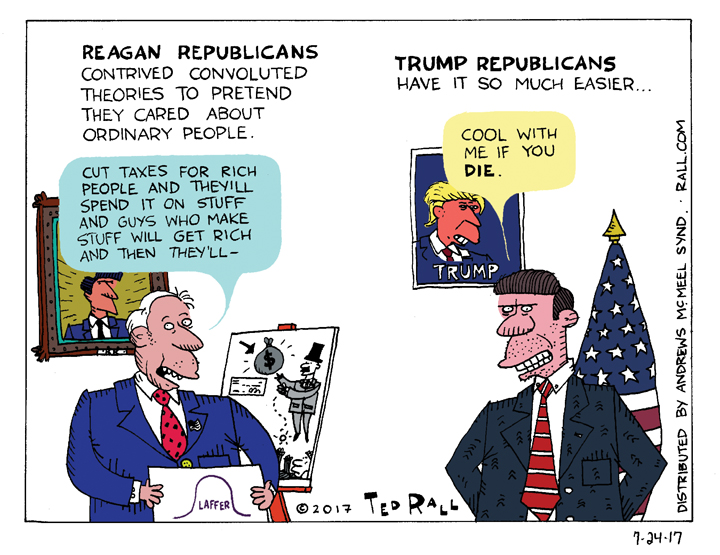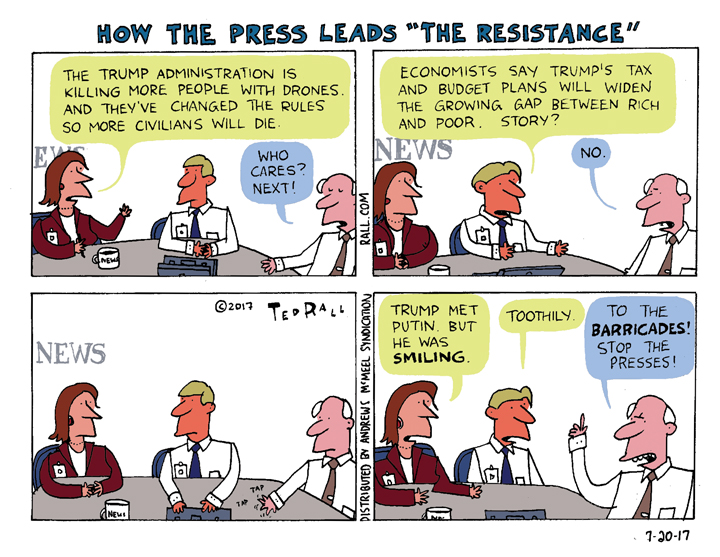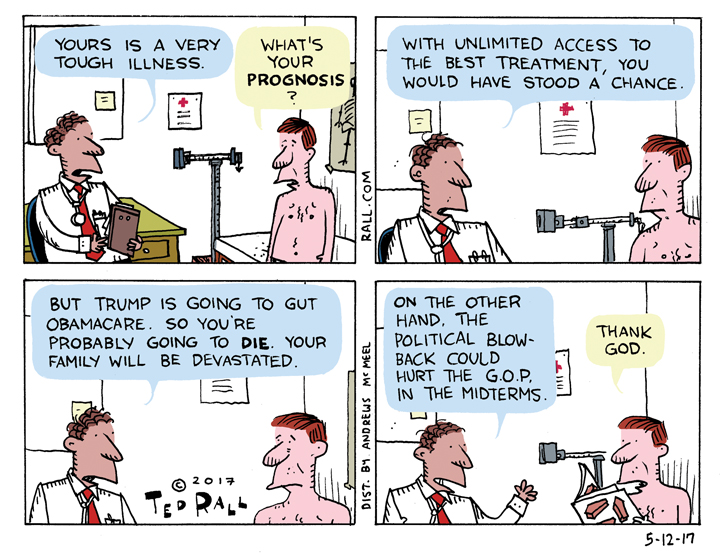After my mother fell and broke her arm, she ended up in the hospital. Medicare covered five days in the hospital and three weeks of rehab. Then the insurance troubles began.
Here is the Progressive Agenda
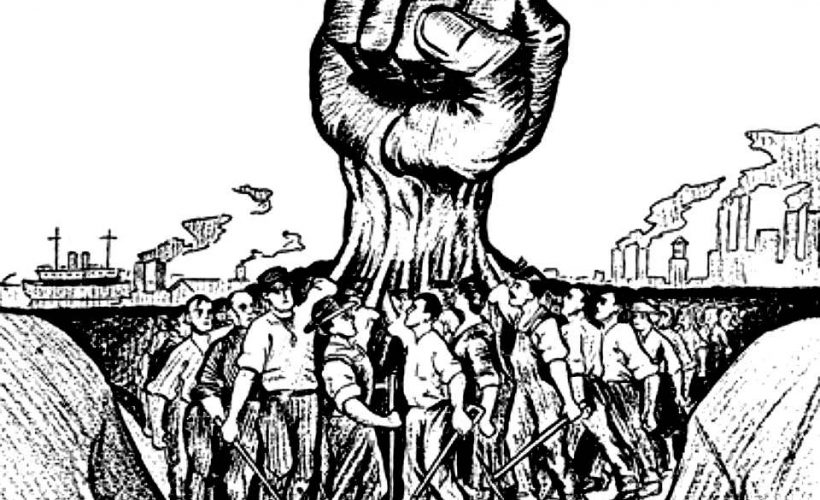
Clintonite corporatists still control the Democratic National Committee despite their long string of failure at the polls. But the overwhelming majority of Democratic Party voters—72%—are self-identified progressives.
44% of House primary candidates in 2018 self-IDed as progressive. If you’re after the Democratic nomination for president you have to be—or pretend to be—progressive. Even Hillary Clinton claimed to be “a progressive who gets things done.”
All the top likely contenders for 2020 claim to be progressive—but they would prefer that voters ignore their voting records and unsavory donors. “Kirsten Gillibrand, Cory Booker, and Kamala Harris have spent the past two years racing to the leftmost edge of respectable opinion,” reports New York magazine. “In recent weeks, they have also all reached out to Wall Street executives, in hopes of securing some funding for their prospective presidential campaign.” It does no good for your heart to be in the right place if your ass is owned by bankers.
“You don’t just get to say that you’re progressive,” Representative Pramila Jayapal, co-chair of the Congressional Progressive Caucus, told progressive donors recently.
Jayapal, a Washington Democrat, called the 2020 election a chance to “leverage our power.” She says it’s critical “that we have some very clear guidelines about what it means to be progressive.”
Here are those guidelines.
You can’t be a progressive unless you favor a big hike in the minimum wage. Elizabeth Warren, the first pretty-much-declared candidate for 2020, wants $15 an hour. But she told a 2013 Senate hearing that it would be $22 if it had kept up with increases in worker productivity. The official inflation rate makes that $24 today. And according to the real inflation rate (the official number as it was calculated before the Labor Department downgraded the calculation in 1980 and 1990) at ShadowStats.com, $22 in 2013 comes to at least $35 today.
If the minimum wage had kept up with inflation since 1968 using the same methodology used to track inflation at the time, it would be closer to $80 per hour.
What should be the progressive demand for the minimum wage? Nothing less than $25 per hour.
(For the record, I see no reason why the minimum wage should be lower than the maximum wage. But we’re talking about progressivism here, not socialism or communism.)
Thanks to Bernie Sanders’ 2016 campaign “free college became a litmus test for liberals,” notes The Atlantic. But a 2017 bill cosponsored by Sanders and Warren defines “college for all” rather narrowly. It only addresses public colleges and universities. It would “make college tuition free for families earning $125,000 a year or less and allow current student loan borrowers to refinance their debt at lower interest rates.”
A quarter of American college students attend private schools. Considering that the average cost is $35,000 a year and some run as high as $60,000, even families earning more than $125,000 need help too.
The progressive stance on college should be three-pronged. First, the obscene $1.5 trillion student loan business should be abolished. Student loans should be replaced by grants but if loans exist at all they should be a zero-profit government program. Second, all outstanding loans should be forgiven or have their interest rates dropped to a zero-profit basis. Third, the government should rein in out-of-control public and private college tuition and fees—which have gone up eight times faster than wages—by tying them to the official federal cost of living index.
Progressives agree that Obamacare didn’t go far enough. With 70% of voters in favor, even centrist Democrats like Kamala Harris have climbed aboard Bernie Sanders’ call for “Medicare for all” bandwagon. Warren, Gillibrand and Booker now say they want single-payer public healthcare. Being progressive, however, means demanding more than what mainstream politicians deem practical—it’s about pushing hard for more ways to improve people’s lives.
In 2020 progressives should be calling for nothing less than universal healthcare. If it’s good enough for the rest of the developed world and many developing countries like Botswana and Bhutan, why not us?
I cosigned a letter to Sanders calling on the Vermont senator to use his platform as the country’s most prominent and popular progressive to talk more about foreign policy and to openly oppose militarism. Now it’s time to get specific.
Progressives should demand that U.S. troops come home from any country that did not attack the United States—i.e., all of them. They should put an end to the disgusting drone wars. The bloated nearly-$1 trillion Pentagon budget should be shredded; let’s see what they can do with $100 billion (which would still be far more than Russia’s defense spending).
From banks that charge usurious credit card interest rates to employers who fire full-time employees and hire them back as “independent contractors,” there are plenty of other targets for progressives to go after.
Progressives: you are no longer the ugly stepdaughter of the Democratic Party. You own the joint.
Now’s the time to demand what’s yours, what you want and what’s right.
(Ted Rall, the cartoonist, columnist and graphic novelist, is the author of “Francis: The People’s Pope.” You can support Ted’s hard-hitting political cartoons and columns and see his work first by sponsoring his work on Patreon.)
SYNDICATED COLUMN: Distractor-in-Chief Trump Is Gaslighting Us Into Forgetting America’s Real Issues

Eight days before Donald J. Trump took his presidential oath before a crowd whose size the president still insists on fibbing about, I wrote a column titled “Life Under Trump—What Happens Now?”
“In a dictatorship, particularly where the despot is a megalomaniac in the vein of a Saddam Hussein or a Muammar Gaddafi, citizens obsess over the Great Leader’s every move. These days, there’s no better place to witness this phenomenon than the Central Asian republic of Turkmenistan,” I wrote on January 12, 2017. I described how the founding dictator of that post-Soviet authoritarian state was manic, “constantly passing edicts and decrees about anything and everything that crossed his mind.”
“Whenever I visited Turkmenistan under Turkmenbashi,” I wrote back then, “the only thing anyone ever talked about – and this included ex-pats – was Turkmenbashi.”
Sadly, my predictions usually come to pass. As I expected, the United States remains a democratic republic but under Trump, everyday life has assumed some of the characteristics of an authoritarian regime, especially our obsession with Trump.
OMG can you believe what he tweeted?
What the hell is wrong with him?
How long can this go on?
Trump’s antics have prompted two strains of pundit reaction. One, represented by the comedian John Oliver, urges us to “keep reminding yourself this is not normal.” Others argue for ignoring the Keeper of the Launch Codes, at least his tweets. Ever the contrarian, I subscribe to None of the Above.
You can’t ignore the President of the United States. He’s too powerful. On the other hand, chasing down and driving rhetorical stakes through a maniac’s barrage of nonsense is exhausting and futile. You feel like a character at dusk in a vampire novel — too many undead, not enough stakes, definitely not enough coffee. The proper tack is insipid: Keep Calm and Carry On.
Here I offer my apologies.
For 15 months I have, like my competitors in the mainstream media, been reacting to Trump: to his tantrums, to his weirdness, and the incongruous hypocrisy of Democrats who complain about stuff Trump does that is exactly the same as what Obama did (mass deportations, bombing Syria). To paraphrase Walter White in the last episode of “Breaking Bad,” it was fun. I enjoyed it. And frankly, I didn’t think he would last this long. Trump was the Political Satirist Full Employment Act of 2016. I didn’t want to miss out.
But I’ve been remiss. I have always tried to be forward-looking, to change the conversation, to argue for what we Americans ought to be doing and talking about. Reacting to the agenda of our worthless political “leaders” was something I left to the mainstream idiots of the corporate media.
I snapped back to reality a few days ago after reading another piece about the booming economy. Never mind whether Trump is priming the pump before busting the joint or whether the good times are about to end with yet another recession. Things are humming now — so now, while the getting is good, is while Americans ought to be demanding that Trump and his Congress fork over big bucks to fix the country’s long-neglected problems.
Workers ought to be out in the streets agitating for a raise: a $25-an-hour minimum wage is literally asking for nothing, since it’s the same, adjusted for inflation, as it was in the 1960s. I say go for $50. While we’re at it, let’s set a $200,000-a-year maximum wage. No one needs more.
Universal health care: it’s time America joined the rest of the First World (and most of the Third).
Three out of ten American workers are self-employed. They ought to qualify for unemployment benefits when they lose work.
A high-speed national rail system is essential to modernize America’s infrastructure and bring it up to global standards circa 1990. Estimated cost: $500 billion. No big deal: Obama spent $800 billion on his 2009 bank-giveaway stimulus bill.
Then there’s stuff that wouldn’t cost a dime, like doing something about guns and gender inequality and police brutality.
Lack of money isn’t why we’re not addressing these issues. Trump recently gave $1.5 trillion in taxpayer funds to his rich friends (and his family). The problem is a lack of focus — because we’re all too busy focusing on the Lunatic-in-Chief.
It’s time to stop being reactive. This is our country. This is our time. These are our lives. It’s up to us to ignore the twitterstorms and the random rants and demand what is our birthright as Americans: the best possible lives we can afford.
(Ted Rall (Twitter: @tedrall), the editorial cartoonist and columnist, is the author of “Francis: The People’s Pope.” You can support Ted’s hard-hitting political cartoons and columns and see his work first by sponsoring his work on Patreon.)
SYNDICATED COLUMN: Donald Trump’s Other Lies: His Campaign Promises

This week’s political coverage — probably next week’s too — will likely be dominated by deposed FBI director James Comey’s incendiary testimony before the Senate Intelligence Committee. However, Trump’s “lies, pure and simple” are limited neither to the president’s claim that Comey’s FBI was “in disarray, that it was poorly led” nor his litany of falsehoods — most recently, that the mayor of London doesn’t care about terrorism and that Trump’s First 100 Days were the most productive of any president in history.
Comey’s lucid, Hemingway-tight testimony feels like the beginning of the end for this administration. Anything could happen, of course. But it feels overly optimistic to imagine this circus lasting another year.
If and when the obituary for Trump’s political career is written, his admirers will record his historic, meteoric rise. Indeed, Donald Trump was the most effective presidential campaigner of my lifetime: repeated what lines worked, ditched the ones that didn’t, mastered social media, ignored outdated dogma, tapped into voters’ long-ignored resentments, nailed the electoral college map, and did it all for pennies on the Hillary Clinton donor dollar.
True, the brilliant campaigner can’t govern. But that’s a story for another time.
His critics’ postmortems will emphasize that Trump’s brightly burning campaign rallies were fueled by lies: Obama was Muslim, Obama wasn’t born here, global warming is a Chinese hoax, illegal immigrants are streaming across the border (years ago they were, no longer), police officers are the real victims (as opposed to the numerous black men they shoot).
These lies are scandalous. They ought to be remembered. But we shouldn’t let them overshadow Trump’s biggest lie of all: that he would be different, outside the ideological box of the two parties.
“Trump meets the textbook definition of an ideological moderate,” Doug Ahler and David Broockman wrote in the Washington Post last December. “Trump has the exact ‘moderate’ qualities that many pundits and political reformers yearn for in politicians: Many of Trump’s positions spurn party orthodoxy, yet are popular among voters. And like most voters — but unlike most party politicians — his positions don’t consistently hew to a familiar left-right philosophy.”
Trump promised a hodgepodge ideology, a “pick one from column D, pick one from column R” Chinese menu that appealed to many voters whose own values don’t neatly adhere to either major party platform. Who cares about doctrine? Let’s do what works.
As president, however, that turned out to be a lie.
Trump has governed to the far right. In fact, on just about every issue you can think of, Donald Trump has governed as the most extreme far-right politician of our lifetimes, and possibly in the history of the Republican Party.
Candidate Trump criticized North Carolina’s “bathroom law” and said Caitlyn Jenner could use whichever bathroom she wanted in Trump Tower. President Trump rescinded the right of transgender students to use the school restroom of their choice.
Flip, flop, from somewhat to right-wing conservative, over and over and over again.
Candidate Trump lit up the GOP (and relieved not a few Democrats) by criticizing the stupid Iraq War and promising to put America First. President Trump’s cabinet of generals is bombing the crap out of Syria and asking Congress for a 10% increase in Pentagon spending.
Candidate Trump was all over the place on abortion rights. President Trump is trying to defund Planned Parenthood and appointed Supreme Court justice Neil Gorsuch, a right-wing extremist who will likely cast the decisive vote against Roe v. Wade.
Candidate Trump promised bigger, better and cheaper healthcare for all Americans. Trumpcare will leave tens of millions of patients with no insurance whatsoever.
He even welched on his most controversial promise: to improve relations with Russia. Within a few months, he allowed that U.S.-Russian relations “may be at an all-time low.”
“Trumpism was never a coherent worldview, much less a moral code that anchors the president,” Graham Vyse wrote in The New Republic.
#Wrong!
Trumpism is extremely coherent and consistently extremist. Donald Trump turns out to be Ronald Reagan times ten, minus charm.
(Ted Rall (Twitter: @tedrall) is author of “Trump: A Graphic Biography,” an examination of the life of the Republican presidential nominee in comics form. You can support Ted’s hard-hitting political cartoons and columns and see his work first by sponsoring his work on Patreon.)

